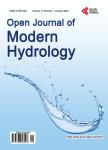Parameter Estimation of a Distributed Hydrological Model Using a Genetic Algorithm
Parameter Estimation of a Distributed Hydrological Model Using a Genetic Algorithm作者机构:Faculty of Engineering Department of Civil Engineering Université de Moncton Moncton Canada INRS Centre Eau-Terre-Environnement Québec City Canada Department of Mathematics and Statistics Faculty of Sciences Université de Moncton Moncton Canada
出 版 物:《Open Journal of Modern Hydrology》 (现代水文学期刊(英文))
年 卷 期:2016年第6卷第3期
页 面:151-167页
学科分类:08[工学] 0812[工学-计算机科学与技术(可授工学、理学学位)]
主 题:Hydrological Modeling Genetic Algorithm CEQUEAU Model Beta Function Miramichi River
摘 要:Water is a vital resource, and can also sometimes be a destructive force. As such, it is important to manage this resource. The prediction of stream flows is an important component of this management. Hydrological models are very useful in accomplishing this task. The objective of this study is to develop and apply an optimization method useful for calibrating a deterministic model of the daily flows of the Miramichi River watershed (New Brunswick). The model used is the CEQUEAU model. The model is calibrated by applying a genetic algorithm. The Nash-Sutcliffe efficiency criterion, modified to penalize physically unrealistic results, was used as the objective function. The model was calibrated using flow data (1975-2000) from a gauging station on the Southwest Miramichi River (catchment area of 5050 km2), obtaining a Nash-Sutcliffe criterion of 0.83. Model validation was performed using flow data (2001-2009) from the same station (Nash-Sutcliffe criterion value of 0.80). This suggests that the model calibration is sufficiently robust to be used for future predictions. A second model validation was performed using data from three other measuring stations on the same watershed. The model performed well in all three additional locations (Nash-Sutcliffe criterion values of 0.77, 0.76 and 0.74), but was performing less well when applied to smaller sub-basins. Nonetheless, the relatively strong performance of the model suggests that it could be used to predict flows anywhere in the watershed, but caution is suggested for applications in small sub-basins. The performance of the CEQUEAU model was also compared to a simple benchmark model (average of each calendar day). A sensitivity analysis was also performed.



